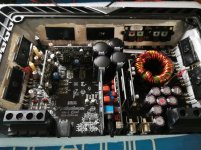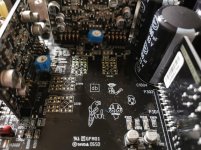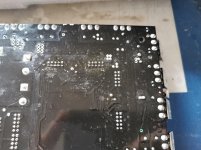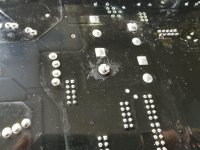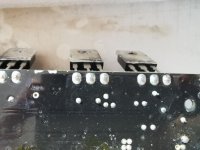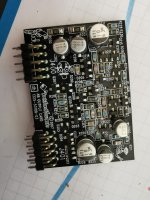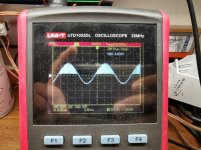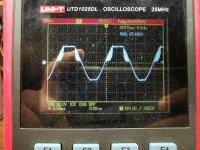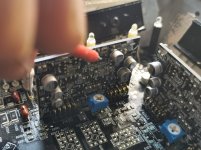I got this amp for repair. The amp works, but has squeezing and hissing output noise. It looks, that somebody had repair it befor allready, because the bias pots are not properly in.
Where i can go to check?? I never had such an amp for repair.
Where i can go to check?? I never had such an amp for repair.
Attachments
The bias pots are often crooked in Rockford amps that use the square pots.
Both channels?
Any noise with no RCAs plugged in?
Does it do it with a signal source with a proper grounded shield?
Is this the same problem that the owner was having?
Both channels?
Any noise with no RCAs plugged in?
Does it do it with a signal source with a proper grounded shield?
Is this the same problem that the owner was having?
I can't help if you don't answer all of the questions. I'm working blind except for the information you provide.
Hello Perry, i tested with my smartphone.
I dont have the same noise as the owner. Only on the left channel i have a little crackling or crispy noise.
The owner send me an audiofile, with high pitch noise on both channels. He installed another amp, the problems are gone.
The amp was connected thru a helix dsp, and worked on the lows and midrange.
I dont have the same noise as the owner. Only on the left channel i have a little crackling or crispy noise.
The owner send me an audiofile, with high pitch noise on both channels. He installed another amp, the problems are gone.
The amp was connected thru a helix dsp, and worked on the lows and midrange.
Amplifiers expect to have a grounded shield. Cell phones don't have a grounded shield and can and have caused problems that didn't really exist.
I would suggest that you check to see if using a shielded ground gave you the same problem as the owner had.
I've had rockford amps like this that would do very strange things (even blow the outputs) if you touched the shields with no RCAs plugged in. I generally connected a 1000pf cap from the shield to the center conductor for each channel and a 27k resistor from each shield to a primary ground. The 27k was used because I had some on the bench that were surplus and used mainly for their leads in various repairs. I don't think the value is critical.
I would suggest that you check to see if using a shielded ground gave you the same problem as the owner had.
I've had rockford amps like this that would do very strange things (even blow the outputs) if you touched the shields with no RCAs plugged in. I generally connected a 1000pf cap from the shield to the center conductor for each channel and a 27k resistor from each shield to a primary ground. The 27k was used because I had some on the bench that were surplus and used mainly for their leads in various repairs. I don't think the value is critical.
Hello Perry,
i tried with a headunit,same powersupply.. Same problem, only crackling on the left channel. Anyway, there is something wrong with that amp.
I know, that helix has a switch, to isolate, or ground or soft ground(200Ohm) the shield to eliminate noise . But he told me, that the amp was working like this about a year. After last switch on, he had a bump in the speakers and then the high pitch noise.. I expect, that the speakerwires are somewhere broken and had connection to car ground..
So where in the amp should i look, to find the crackling noise. I expect, that it come from the preamp, because output stage looks fine.
i tried with a headunit,same powersupply.. Same problem, only crackling on the left channel. Anyway, there is something wrong with that amp.
I know, that helix has a switch, to isolate, or ground or soft ground(200Ohm) the shield to eliminate noise . But he told me, that the amp was working like this about a year. After last switch on, he had a bump in the speakers and then the high pitch noise.. I expect, that the speakerwires are somewhere broken and had connection to car ground..
So where in the amp should i look, to find the crackling noise. I expect, that it come from the preamp, because output stage looks fine.
Push/move everything you can to see if it makes a difference.
Operate all pots and switches to see if that makes a difference.
It's hard to follow the signal without the diagram due to the vertical boards. You can check with Rockford but I don't think they released this diagram yet.
The double-row header are hard to remove without damage to the main board unless you use chipquik.
Operate all pots and switches to see if that makes a difference.
It's hard to follow the signal without the diagram due to the vertical boards. You can check with Rockford but I don't think they released this diagram yet.
The double-row header are hard to remove without damage to the main board unless you use chipquik.
If i touch the 0,1Ohm resistors, the crackling changed. I removed the board, and found a bad repair. Also it seems, that the board was wet before.. Some green spots on the vias and solder joints.
Attachments
Received the amp back from the owner. This time the other channel is slightly disorted. Iam wondering, why there is no change in amperage drawing, when i turn the bias pot...
Here are the waveform.
Update... Turned the pot, now the upper half is completely missing.
Update... Turned the pot, now the upper half is completely missing.
Attachments
Last edited:
The high side drive is very weak in amplitude, if I compare it to the other side. Now the upper wave is completely gone. Anyway, very weak drive. I expect a cold solder joint.
I have already weak signal on the drive transistors.
I have already weak signal on the drive transistors.
Well, at least you have a starting point and another channel for reference. Work your way back to see where you lose signal.
I do not. I haven't seen colder solder issues in any Rockford amp, as far as I can remember. The exception is for components that have overheated due to other problems (snubber resistors and such). It's actually almost unheard of in any amp except some that are single-sided (generally where the through-holes are too large).
The only types of boards that I've seen with solder issues were the double-sided CEM boards without feed-throughs that have solder connections on both sides of the board for a single component terminal. For those, you can expect problems.
The only types of boards that I've seen with solder issues were the double-sided CEM boards without feed-throughs that have solder connections on both sides of the board for a single component terminal. For those, you can expect problems.
- Home
- General Interest
- Car Audio
- Rockford Fosgate T600-2
